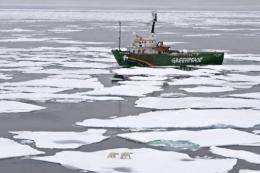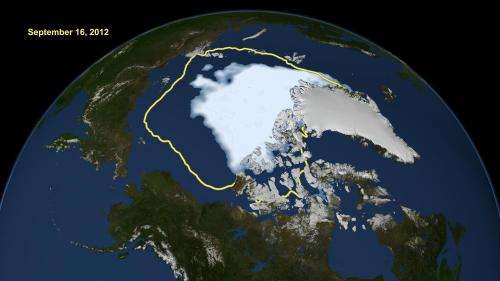Arctic ice shrinks to all-time low; half 1980 size (Update)

In a critical climate indicator showing an ever warming world, the amount of ice in the Arctic Ocean shrank to an all-time low this year, obliterating old records.
The ice cap at the North Pole measured 1.32 million square miles (3.42 million sq. kilometers) on Sunday. That's 18 percent smaller than the previous record of 1.61 million square miles (4.17 million sq. kilometers) set in 2007, according to the National Snow and Ice Data Center in Boulder, Colorado. Records go back to 1979 based on satellite tracking.
"On top of that, we're smashing a record that smashed a record," said data center scientist Walt Meier. Sea ice shrank in 2007 to levels 22 percent below the previous record of 2005.
Ice in the Arctic melts in summer and grows in winter, and it started growing again on Monday. In the 1980s, Meier said, summer sea ice would cover an area slightly smaller than the mainland. U.S. Now it is about half that.
Man-made global warming has melted more sea ice and made it thinner over the last couple decades with it getting much more extreme this year, surprisingly so, said snow and ice data center director Mark Serreze.

"Recently the loss of summer ice has accelerated and the six lowest September ice extents have all been in the past six years," Serreze said. "I think that's quite remarkable."
Serreze said except for one strong storm that contributed to the ice loss, this summer melt was more from the steady effects of day-to-day global warming. But he and others say the polar regions are where the globe first sees the signs of climate change.
"Arctic sea ice is one of the most sensitive of nature's thermometers," said Jason Box, an Ohio State University polar researcher.
What happens in the Arctic changes climate all over the rest of the world, scientists have reported in studies.
The ice in the Arctic "essentially acts like an air conditioner by keeping things cooler," Meier said. And when sea ice melts more, it's like the air conditioner isn't running efficiently, he said.
Sea ice reflects more than 90 percent of the sun's heat off the Earth, but when it is replaced by the darker open ocean, more than half of the heat is absorbed into the water, Meier said.
Scientists at the snow and ice data center said their computer models show an Arctic that would be essentially free of ice in the summer by 2050, but they add that current trends show ice melting faster than the computers are predicting.
Copyright 2012 The Associated Press. All rights reserved. This material may not be published, broadcast, rewritten or redistributed.




















